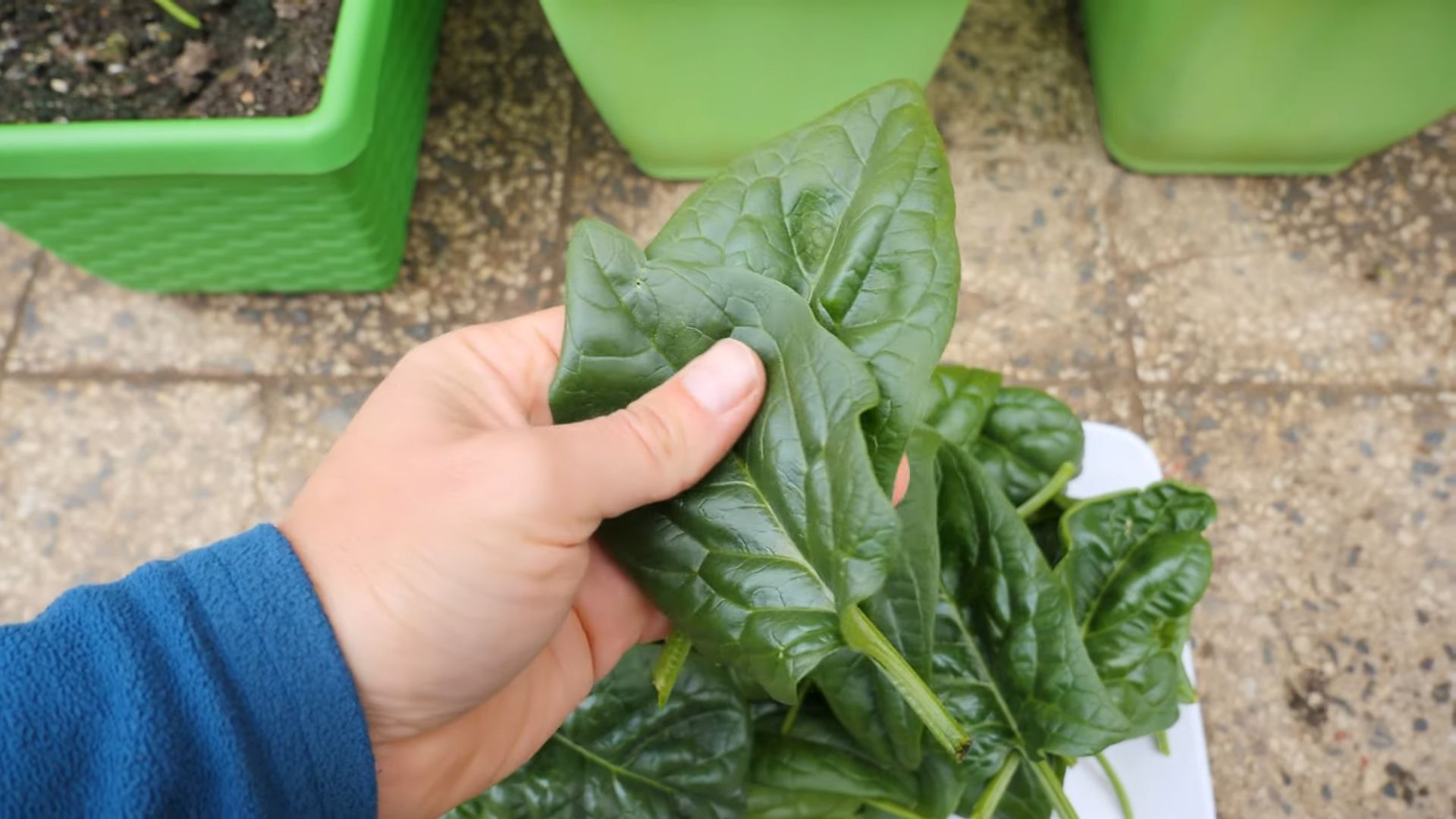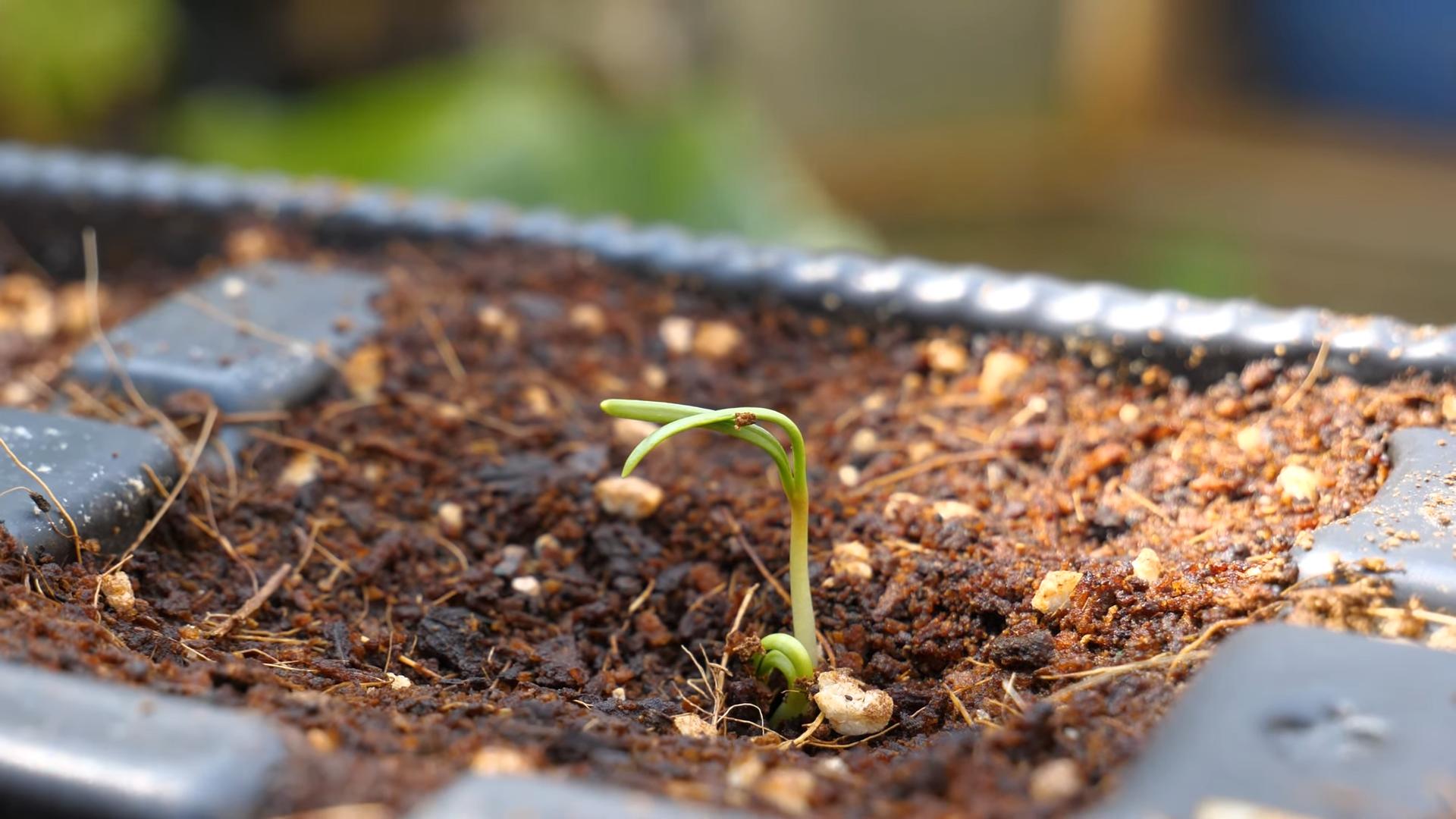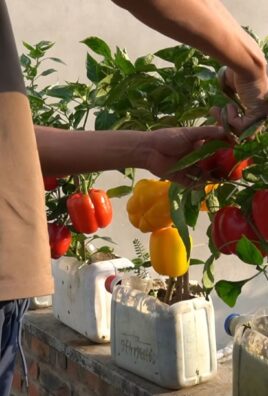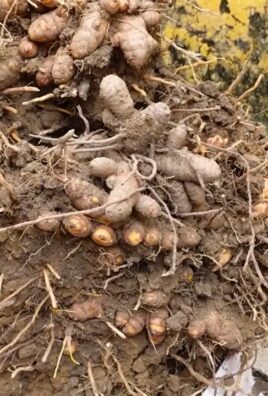Grow Spinach in a Pot? Absolutely! Imagine stepping outside your door and harvesting fresh, vibrant spinach leaves for your salad, smoothie, or stir-fry. No sprawling garden needed! For centuries, cultivating food close to home has been a cornerstone of self-sufficiency and a connection to nature. From ancient rooftop gardens in Babylon to the modern-day victory gardens of wartime, growing your own food, even in a small space, has always been empowering.
But let’s be honest, not everyone has the space or time for a traditional garden. That’s where the magic of container gardening comes in. And that’s why I’m so excited to share this simple yet effective DIY trick with you. Learning how to grow spinach in a pot is easier than you think, and it opens up a world of fresh, healthy possibilities, even if you only have a balcony or a sunny windowsill.
This guide will walk you through everything you need to know, from choosing the right pot and soil to watering and harvesting your delicious, homegrown spinach. Say goodbye to wilted, overpriced spinach at the grocery store and hello to a constant supply of fresh greens right at your fingertips! Let’s get started!

Grow Your Own Spinach Oasis: A Beginner’s Guide to Pot-Grown Goodness
Hey there, fellow plant enthusiasts! Ever dreamt of snipping fresh, vibrant spinach leaves right from your own balcony or patio? Well, dream no more! Growing spinach in pots is surprisingly easy and rewarding, even if you’re a complete newbie like I was. This guide will walk you through every step, from choosing the right pot to harvesting your delicious, homegrown spinach. Let’s get started!
Choosing the Right Pot and Soil
First things first, we need to create the perfect home for our spinach babies. Here’s what to consider:
* Pot Size: Spinach needs room to spread its roots. I recommend a pot that’s at least 6-8 inches deep and 12 inches in diameter. This will give your spinach plants enough space to thrive. You can also use a long rectangular planter to grow multiple plants together.
* Drainage: This is crucial! Spinach hates soggy feet. Make sure your pot has drainage holes at the bottom to allow excess water to escape. If your pot doesn’t have enough holes, you can drill a few more.
* Material: Plastic, terracotta, or even fabric pots will work. Terracotta pots dry out faster, so you’ll need to water more frequently. Plastic pots retain moisture better, but be careful not to overwater. I personally love using fabric pots because they allow for excellent drainage and aeration.
* Soil: Don’t even think about using garden soil! It’s often too heavy and doesn’t drain well enough for container gardening. Instead, opt for a high-quality potting mix. Look for a mix that’s specifically formulated for vegetables or contains compost, perlite, and vermiculite. These ingredients will help with drainage, aeration, and nutrient retention.
Planting Your Spinach Seeds
Now for the fun part – planting!
1. Gather Your Supplies: You’ll need your chosen pot, potting mix, spinach seeds, a watering can, and a small trowel or spoon.
2. Fill the Pot: Fill your pot with potting mix, leaving about an inch of space at the top. Gently pat down the soil to remove any air pockets.
3. Sow the Seeds: Spinach seeds are small, so handle them carefully. Sprinkle the seeds evenly over the surface of the soil, spacing them about 1-2 inches apart.
4. Cover the Seeds: Lightly cover the seeds with about 1/2 inch of potting mix.
5. Water Gently: Use a watering can with a gentle rose attachment to water the soil thoroughly. Avoid blasting the seeds with a strong stream of water, as this can dislodge them.
6. Label Your Pot: Don’t forget to label your pot with the date and type of spinach you planted. This will help you keep track of your progress.
Caring for Your Spinach Plants
Spinach is relatively low-maintenance, but here are a few key things to keep in mind:
* Sunlight: Spinach loves sunshine, but it can also tolerate partial shade. Aim for at least 4-6 hours of direct sunlight per day. If you live in a hot climate, provide some afternoon shade to prevent the leaves from wilting.
* Watering: Keep the soil consistently moist, but not soggy. Water when the top inch of soil feels dry to the touch. Avoid overwatering, as this can lead to root rot. I usually check the soil moisture every day and water as needed.
* Fertilizing: Spinach is a heavy feeder, so it needs regular fertilization. Use a balanced liquid fertilizer diluted to half strength every 2-3 weeks. You can also add compost tea to the soil for an extra boost of nutrients.
* Thinning: Once your spinach seedlings have a few true leaves (the leaves that appear after the initial seed leaves), you’ll need to thin them out. This means removing some of the seedlings to give the remaining plants more space to grow. Aim for a spacing of about 4-6 inches between plants. Don’t throw away the thinned seedlings! You can eat them as microgreens.
* Weeding: Keep an eye out for weeds and remove them promptly. Weeds can compete with your spinach plants for nutrients and water.
* Pest Control: Spinach is generally pest-resistant, but it can sometimes be affected by aphids, slugs, or snails. Check your plants regularly for signs of pests and take action if necessary. You can use organic pest control methods, such as insecticidal soap or diatomaceous earth. I’ve found that hand-picking slugs and snails is also effective.
Harvesting Your Spinach
The moment you’ve been waiting for!
1. When to Harvest: You can start harvesting spinach leaves when they are about 4-6 inches long. The younger leaves are more tender and have a milder flavor.
2. How to Harvest: Use a pair of scissors or garden shears to cut the outer leaves, leaving the inner leaves to continue growing. This is known as “cut and come again” harvesting, and it allows you to harvest spinach multiple times from the same plant.
3. Harvesting Time: Harvest in the morning, when the leaves are crisp and cool.
4. Storage: Wash the harvested spinach leaves thoroughly and store them in a plastic bag in the refrigerator. They will keep for several days.
Troubleshooting
Even with the best care, you might encounter a few challenges along the way. Here are some common problems and how to fix them:
* Yellowing Leaves: This could be a sign of overwatering, underwatering, or nutrient deficiency. Check the soil moisture and adjust your watering schedule accordingly. If the soil is dry, water deeply. If the soil is soggy, allow it to dry out before watering again. You can also try fertilizing your plants with a balanced liquid fertilizer.
* Wilting Leaves: This could be caused by heat stress, underwatering, or root rot. Provide some afternoon shade to protect your plants from the hot sun. Water deeply when the soil feels dry. If you suspect root rot, check the drainage of your pot and make sure the soil is not waterlogged.
* Slow Growth: This could be due to lack of sunlight, nutrient deficiency, or overcrowding. Make sure your plants are getting enough sunlight and fertilize them regularly. Thin out the seedlings if they are too crowded.
* Pests: As mentioned earlier, spinach can sometimes be affected by aphids, slugs, or snails. Use organic pest control methods to get rid of these pests.
Choosing Spinach Varieties
There are many different varieties of spinach to choose from, each with its own unique characteristics. Here are a few popular options:
* Bloomsdale: This is a classic spinach variety with dark green, crinkled leaves. It’s known for its excellent flavor and cold hardiness.
* Tyee: This is a smooth-leafed spinach variety that’s resistant to bolting (going to seed). It’s a good choice for warmer climates.
* Malabar Spinach: While technically not a true spinach, Malabar spinach is a heat-tolerant alternative that can be grown in hot weather. It has thick, fleshy leaves that can be used in salads or cooked like spinach.
* Red Cardinal: This variety has beautiful red-veined leaves that add a pop of color to your garden. It’s also very nutritious and has a mild flavor.
Extending Your Spinach Season
Spinach is a cool-season crop, which means it grows best in the spring and fall. However, you can extend your spinach season by using a few simple techniques:
* Succession Planting: Sow new seeds every 2-3 weeks to ensure a continuous harvest.
* Cold Frames or Row Covers: Use cold frames or row covers to protect your plants from frost and extend the growing season into the winter.
* Shade Cloth: Use shade cloth to protect your plants from the hot sun during the summer.
Enjoying Your Homegrown Spinach
Now that you’ve successfully grown your own spinach, it’s time to enjoy the fruits (or rather, leaves) of your labor! Here are a few ideas:
* Salads: Add fresh spinach leaves to your favorite salads for a boost of nutrients and flavor.
* Smoothies: Blend spinach into your smoothies for a healthy and delicious green drink.
* Sauteed Spinach: Saute spinach with garlic and olive oil for a simple and flavorful side dish.
* Spinach Dip: Use your homegrown spinach to make a creamy and delicious spinach dip.
* Spinach Pie: Bake a savory spinach pie with feta cheese and phyllo dough.
Growing spinach in pots is a rewarding experience that allows you to enjoy fresh, healthy greens right at your fingertips. With a little bit of care and attention, you can create your own spinach oasis and impress your friends and family with your gardening skills. Happy growing!

Conclusion
So, there you have it! Growing spinach in a pot is not only achievable but also incredibly rewarding. Forget those limp, pre-packaged greens from the supermarket. Imagine stepping out onto your balcony or patio and harvesting fresh, vibrant spinach leaves whenever you need them. The taste difference alone is enough to convince anyone to give this a try.
This DIY trick is a must-try for several reasons. First, it’s incredibly space-efficient. Even if you live in an apartment with limited outdoor space, you can still enjoy the benefits of homegrown spinach. Second, it gives you complete control over the growing environment. You can choose the best soil, provide optimal sunlight, and protect your plants from pests and diseases more easily than you could in a traditional garden. Third, it’s a fantastic way to reduce your carbon footprint and support sustainable living. By growing your own food, you’re reducing your reliance on industrial agriculture and transportation.
But the best reason to try growing spinach in a pot is the sheer satisfaction of nurturing something from seed to harvest. There’s something deeply fulfilling about watching those tiny seeds sprout and transform into lush, leafy greens. It’s a connection to nature that can be incredibly grounding and therapeutic.
Don’t be afraid to experiment with different varieties of spinach. Some are better suited for container gardening than others. Consider trying baby spinach, which matures quickly and produces tender leaves. Or, if you’re looking for something with a bit more texture, try savoy spinach. You can also add companion plants to your pot, such as marigolds, which can help deter pests. Another variation is to use different types of containers. While terracotta pots are classic and beautiful, plastic pots are lighter and retain moisture better. Self-watering pots can also be a great option for busy gardeners.
We’ve provided you with all the information you need to get started, from choosing the right pot and soil to watering and fertilizing your plants. Now it’s your turn to put your green thumb to the test. We are confident that you will find the process of growing spinach in a pot to be both enjoyable and rewarding.
Don’t hesitate to get creative and adapt the techniques to suit your own needs and preferences. The most important thing is to have fun and learn along the way.
We encourage you to try this DIY trick and share your experience with us. Post photos of your spinach plants on social media and tag us. We’d love to see your progress and hear about your successes (and any challenges you encounter). Together, we can inspire others to embrace the joys of homegrown food and create a more sustainable future. So, grab a pot, some soil, and some spinach seeds, and get ready to enjoy the freshest, most delicious spinach you’ve ever tasted! Let’s get growing!
FAQ
Frequently Asked Questions About Growing Spinach in a Pot
1. What is the best size pot for growing spinach?
A pot that is at least 6-8 inches deep and 6-8 inches in diameter is generally sufficient for growing spinach. However, a larger pot (12 inches or more in diameter) will allow you to grow more plants and provide more room for the roots to develop. The bigger the pot, the more moisture it will retain, which can be beneficial, especially in warmer climates. Ensure the pot has drainage holes to prevent waterlogging.
2. What type of soil should I use for growing spinach in a pot?
Spinach thrives in well-draining, nutrient-rich soil. A good quality potting mix is essential. Avoid using garden soil, as it can be too heavy and may not drain properly in a container. You can also amend your potting mix with compost or other organic matter to improve its fertility and drainage. A slightly acidic to neutral pH (around 6.5 to 7.0) is ideal for spinach.
3. How much sunlight does spinach need when grown in a pot?
Spinach needs at least 4-6 hours of sunlight per day. However, in hot climates, it’s best to provide some afternoon shade to prevent the leaves from wilting or bolting (going to seed prematurely). A location that receives morning sun and afternoon shade is ideal. If you don’t have a sunny spot, you can supplement with grow lights.
4. How often should I water spinach in a pot?
Spinach needs consistent moisture to thrive. Water your plants regularly, especially during hot, dry weather. Check the soil moisture by sticking your finger about an inch into the soil. If it feels dry, it’s time to water. Avoid overwatering, as this can lead to root rot. Water deeply, allowing the water to drain out of the bottom of the pot.
5. How do I fertilize spinach grown in a pot?
Spinach is a heavy feeder and benefits from regular fertilization. Use a balanced, water-soluble fertilizer every 2-3 weeks. You can also amend the soil with compost or other organic matter to provide a slow-release source of nutrients. Avoid over-fertilizing, as this can lead to excessive leaf growth and a bitter taste.
6. What are some common pests and diseases that affect spinach grown in pots?
Common pests that can affect spinach include aphids, spider mites, and leaf miners. Check your plants regularly for signs of infestation and take action promptly. You can use insecticidal soap or neem oil to control these pests. Diseases that can affect spinach include downy mildew and powdery mildew. Ensure good air circulation around your plants and avoid overwatering to prevent these diseases.
7. When is the best time to harvest spinach from a pot?
You can start harvesting spinach leaves when they are about 4-6 inches long. Harvest the outer leaves first, leaving the inner leaves to continue growing. This will allow you to enjoy a continuous harvest over several weeks. Avoid harvesting during the hottest part of the day, as the leaves will be more likely to wilt.
8. Can I grow spinach in a pot indoors?
Yes, you can grow spinach in a pot indoors, but you will need to provide adequate light. Place your pot near a sunny window that receives at least 6 hours of direct sunlight per day. If you don’t have enough natural light, you can supplement with grow lights. You will also need to ensure good air circulation and maintain a consistent temperature.
9. How do I prevent spinach from bolting (going to seed) in a pot?
Bolting is a common problem with spinach, especially in hot weather. To prevent bolting, choose bolt-resistant varieties of spinach, provide afternoon shade, and water your plants regularly. You can also mulch around the base of the plants to help keep the soil cool. If your spinach does start to bolt, harvest the leaves immediately, as they will become bitter.
10. Can I grow other vegetables in the same pot as spinach?
While it’s generally best to give spinach its own pot to ensure it gets the nutrients and space it needs, you can potentially grow it with companion plants. Good companion plants for spinach include radishes, lettuce, and marigolds. Avoid planting spinach with plants that compete for nutrients or attract pests. Be sure to provide enough space for all the plants to grow and thrive.




Leave a Comment